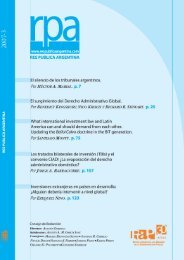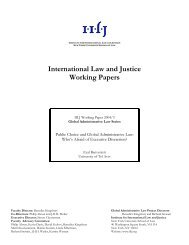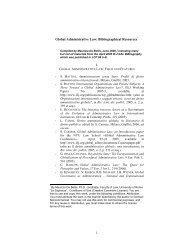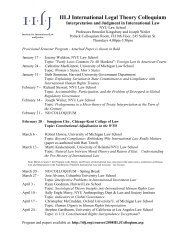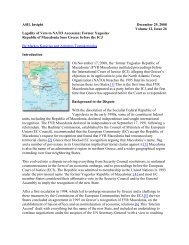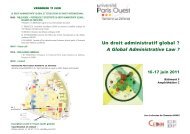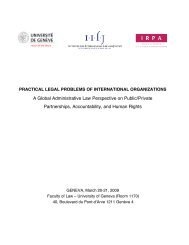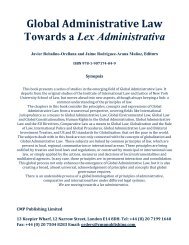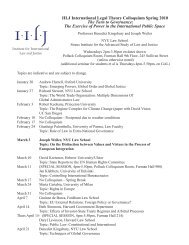brought under the dominican republic - central america - ita
brought under the dominican republic - central america - ita
brought under the dominican republic - central america - ita
Create successful ePaper yourself
Turn your PDF publications into a flip-book with our unique Google optimized e-Paper software.
6.13. The Claimant submits that <strong>the</strong> Respondent decided at <strong>the</strong> outset that it would “bifurcate”<br />
its preliminary objections. Thus, on 4 January 2010, <strong>the</strong> Respondent launched<br />
its Preliminary Objections <strong>under</strong> CAFTA Articles 10.20.4 and 10.20.5. Although<br />
objections <strong>under</strong> Article 10.20.4 must be made “as a matter of law” and assuming<br />
<strong>the</strong> Claimant's factual allegations “to be true,” <strong>the</strong> Respondent made innumerable<br />
factual arguments that it plainly knew to be disputed by <strong>the</strong> Claimant. Indeed, those<br />
arguments necess<strong>ita</strong>ted <strong>the</strong> submission of 54 exhibits consisting of nearly 800 pages<br />
of material, notwithstanding that <strong>the</strong> Preliminary Objections were supposed to be<br />
based on <strong>the</strong> facts as alleged by Claimant in <strong>the</strong> Notice of Arbitration.<br />
6.14. In <strong>the</strong> meantime, so <strong>the</strong> Claimant contends, <strong>the</strong> Respondent was preparing its second<br />
set of jurisdictional objections even as its Preliminary Objections were still being<br />
prepared. For example, by 1 March 2010, <strong>the</strong> Respondent had already carried out a<br />
full “investigation”, which, so <strong>the</strong> Respondent informed <strong>the</strong> United States Government,<br />
“conclusively” proved that it was entitled to deny <strong>the</strong> Claimant <strong>the</strong><br />
benefits of CAFTA; when <strong>the</strong> Respondent filed its Objections to Jurisdiction on 3<br />
August 2010 (literally within hours of <strong>the</strong> Tribunal's Decision of 2 August 2010),<br />
<strong>the</strong> Respondent based its arguments largely, if not entirely, on <strong>the</strong> same<br />
grounds that purportedly supported its case in <strong>the</strong> letter of 1 March 2010 to <strong>the</strong><br />
USA (although <strong>the</strong> Respondent failed to provide ei<strong>the</strong>r <strong>the</strong> Claimant or <strong>the</strong> Tribunal<br />
with such letter until 3 September 2010).<br />
6.15. Fur<strong>the</strong>rmore, so <strong>the</strong> Claimant contends, given <strong>the</strong> nature of <strong>the</strong> two sets of objections,<br />
<strong>the</strong>re is no legitimate reason why <strong>the</strong> Respondent could not have asserted <strong>the</strong>m<br />
toge<strong>the</strong>r. The Claimant submits that <strong>the</strong> arguments included in <strong>the</strong> Respondent‟s Objections<br />
to Jurisdiction are no more fact-intensive than those that <strong>the</strong> Respondent put<br />
forward in its first round of objections <strong>under</strong> CAFTA Article 10.20.4. Thus, so <strong>the</strong><br />
Claimant contends, <strong>the</strong> information on which <strong>the</strong> Respondent based its letter dated 1<br />
March 2010 to <strong>the</strong> USA (as well as <strong>the</strong> Respondent‟s subsequent denial of benefits<br />
to <strong>the</strong> Claimant) consists almost entirely of <strong>the</strong> Claimant‟s own public filings or<br />
o<strong>the</strong>r information that <strong>the</strong> Claimant had made publicly available. In turn, <strong>the</strong> Respondent's<br />
Objection to Jurisdiction based on Abuse of Process is, according to <strong>the</strong><br />
Claimant, largely based on <strong>the</strong> same <strong>under</strong>lying facts as <strong>the</strong> Objection based on Denial<br />
of Benefits; <strong>the</strong> facts required to demonstrate that <strong>the</strong> Tribunal has jurisdic-<br />
Part 6 - Page 4



